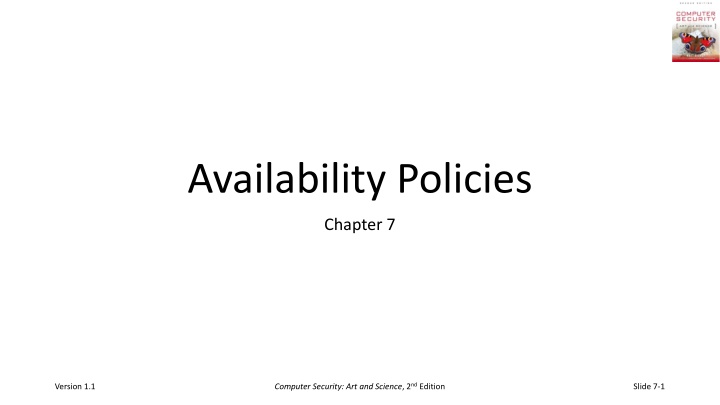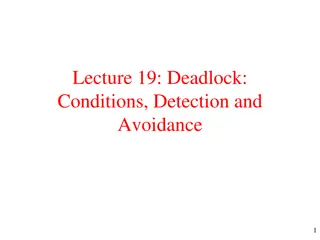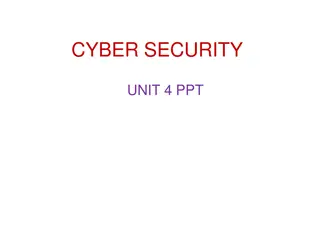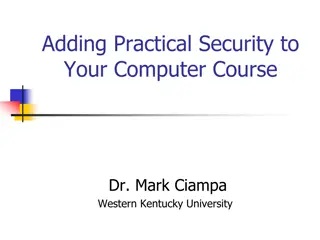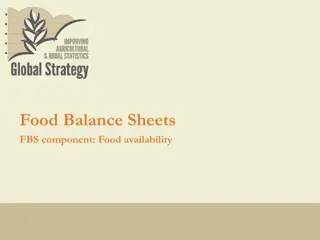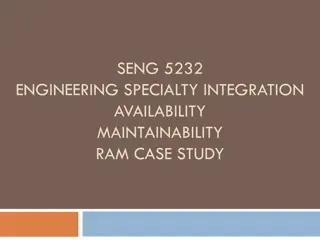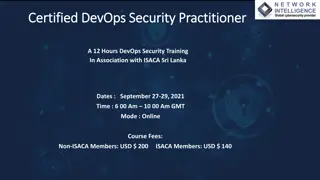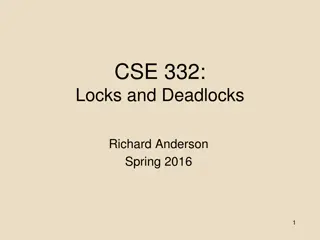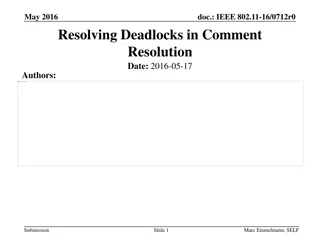Computer Security: Ensuring Availability and Preventing Deadlocks
This content discusses the importance of ensuring resource availability in computer security, focusing on goals, deadlock scenarios, and approaches to solving deadlocks. It highlights key differences in mechanisms supporting availability and the various factors contributing to deadlocks in system processes. Strategies such as prevention, avoidance, and detection are explored to manage and mitigate deadlocks effectively.
Download Presentation

Please find below an Image/Link to download the presentation.
The content on the website is provided AS IS for your information and personal use only. It may not be sold, licensed, or shared on other websites without obtaining consent from the author.If you encounter any issues during the download, it is possible that the publisher has removed the file from their server.
You are allowed to download the files provided on this website for personal or commercial use, subject to the condition that they are used lawfully. All files are the property of their respective owners.
The content on the website is provided AS IS for your information and personal use only. It may not be sold, licensed, or shared on other websites without obtaining consent from the author.
E N D
Presentation Transcript
Availability Policies Chapter 7 Computer Security: Art and Science, 2nd Edition Version 1.1 Slide 7-1
Outline Goals Deadlock Denial of service Constraint-based model State-based model Networks and flooding Amplification attacks Computer Security: Art and Science, 2nd Edition Version 1.1 Slide 7-2
Goals Ensure a resource can be accessed in a timely fashion Called quality of service Timely fashion depends on nature of resource, the goals of using it Closely related to safety and liveness Safety: resource does not perform correctly the functions that client is expecting Liveness: resource cannot be accessed Computer Security: Art and Science, 2nd Edition Version 1.1 Slide 7-3
Key Difference Mechanisms to support availability in general Lack of availability assumes average case, follows a statistical model Mechanisms to support availability as security requirement Lack of availability assumes worst case, adversary deliberately makes resource unavailable Failures are non-random, may not conform to any useful statistical model Computer Security: Art and Science, 2nd Edition Version 1.1 Slide 7-4
Deadlock A state in which some set of processes block each waiting for another process in set to take come action Mutual exclusion: resource not shared Hold and wait: process must hold resource and block, waiting other needed resources to become available No preemption: resource being held cannot be released Circular wait: set of entities holding resources such that each process waiting for another process in set to release resources Usually not due to an attack Computer Security: Art and Science, 2nd Edition Version 1.1 Slide 7-5
Approaches to Solving Deadlocks Prevention: prevent 1 of the 4 conditions from holding Do not acquire resources until all needed ones are available When needing a new resource, release all held Avoidance: ensure process stays in state where deadlock cannot occur Safe state: deadlock can not occur Unsafe state: may lead to state in which deadlock can occur Detection: allow deadlocks to occur, but detect and recover Computer Security: Art and Science, 2nd Edition Version 1.1 Slide 7-6
Denial of Service Occurs when a group of authorized users of a service make that service unavailable to a (disjoint) group of authorized users for a period of time exceeding a defined maximum waiting time First group of authorized users here is group of users with access to service, whether or not the security policy grants them access Often abbreviated DoS or DOS Assumes that, in the absence of other processes, there are enough resources Otherwise problem is not solvable unless more resources created Inadequate resources is another type of problem Computer Security: Art and Science, 2nd Edition Version 1.1 Slide 7-7
Components of DoS Model Waiting time policy: controls the time between a process requesting a resource and being allocated that resource Denial of service occurs when this waiting time exceeded Amount of time depends on environment, goals User agreement: establishes constraints that process must meet in order to access resource Here, user means a process These ensure a process will receive service within the waiting time Computer Security: Art and Science, 2nd Edition Version 1.1 Slide 7-8
Constraint-Based Model (Yu-Gligor) Framed in terms of users accessing a server for some services User agreement: describes properties that users of servers must meet Finite waiting time policy: ensures no user is excluded from using resource Computer Security: Art and Science, 2nd Edition Version 1.1 Slide 7-9
User Agreement Set of constraints designed to prevent denial of service Sseq sequence of all possible invocations of a service Useq set of sequences of all possible invocations by a user UIi,seq Useq that user Ui can invoke C set of operations Ui can perform to consume service P set of operations to produce service user Ui consumes p < c means operation p P must precede operation c C Ai set of operations allowed for user Ui Ri set of relations between every pair of allowed operations for Ui Computer Security: Art and Science, 2nd Edition Version 1.1 Slide 7-10
Example Mutually exclusive resource C = { acquire } P = { release } For p1, p2, Ai = { acquirei, releasei } for i = 1, 2 For p1, p2, Ri = { ( acquirei < releasei ) } for i = 1, 2 Computer Security: Art and Science, 2nd Edition Version 1.1 Slide 7-11
Sequences of Operations Ui(k) initial subsequence of Ui of length k no(Ui(k)) number of times operation o occurs in Ui(k) Ui(k) safe if the following 2 conditions hold: if o Ui,seq, then o Ai; and That is, if Ui executes o, it must be an allowed operation for Ui for all k, if (o < o ) Ri, then no(Ui(k)) no (Ui(k)) That is, if one operation precedes another, the first one must occur more times than the second Computer Security: Art and Science, 2nd Edition Version 1.1 Slide 7-12
Resources of Services s Sseq possible sequence of invocations of services s blocks on condition c May be waiting for service to become available, or processing some response, etc. oi*(c) represents operation oi blocked, waiting for c to become true When execution results, oi(c) represents operation Note that when c becomes true, oi*(c) may not resume immediately Computer Security: Art and Science, 2nd Edition Version 1.1 Slide 7-13
Resources of Services s(0) initial subsequence of s up to operation oi*(c) s(k) subsequence of operations between k-1st, kth time c becomes true after oi*(c) oi*(c) s(k)oi(c): oi blocks waiting on c at end of s(0), resumes operation at end of s(k) Sseqlive if for every oi*(c) there is a set of subsequences s(0), ..., s(k) such that it is initial subsequence of some s Sseq and oi*(c) s(k)oi(c) Computer Security: Art and Science, 2nd Edition Version 1.1 Slide 7-14
Example Mutually exclusive resource; consider sequence ( acquirei, releasei, acquirei, acquirei, releasei) with acquirei, releasei Ai, (acquirei, releasei) Ri;o = acquirei, o = releasei Ui(1) = (acquirei ) no(Ui(1)) = 1, no (Ui(1)) = 0 Ui(2) = (acquirei, releasei ) no(Ui(2)) = 1, no (Ui(2)) = 1 Ui(3) = (acquirei, releasei, acquirei) no(Ui(3)) = 2, no (Ui(3)) = 1 Ui(4) = (acquirei, releasei, acquirei, acquirei) no(Ui(4)) = 3, no (Ui(4)) = 1 Ui(5) = (acquirei, releasei, acquirei, acquirei, releasei) no(Ui(5)) = 3, no (Ui(5)) = 2 As no(Ui(k)) no (Ui(k)) for k = 1, ..., 5, the sequence is safe Computer Security: Art and Science, 2nd Edition Version 1.1 Slide 7-15
Example (cont) Let c be true whenever resource can be released That is, initially and whenever a releasei operation is performed Consider sequence: (acquire1, acquire2*(c), release1, release2, ... , acquirek, acquirek+1(c), releasek, releasek+1, ...) For all k 1, acquirei*(c) s(1)acquirek+1(c), so this is live sequence Here, acquirek+1(c) occurs between releasek and releasek+1 Computer Security: Art and Science, 2nd Edition Version 1.1 Slide 7-16
Expressing User Agreements Use temporal logics Symbols : henceforth (the predicate is true and will remain true) : eventually (the predicate is either true now, or will become true in the future) : will lead to (if the first part is true, the second part will eventually become true); so A B is shorthand for A B Computer Security: Art and Science, 2nd Edition Version 1.1 Slide 7-17
Example Acquiring and releasing mutually exclusive resource type User agreement: once a process is blocked on an acquire operation, enough release operations will release enough resources of that type to allow blocked process to proceed service resource_allocator User agreement in(acquire) (( (#active_release > 0) (free acquire.n)) When a process issues an acquire request, at some later time at least 1 release operation occurs, and enough resources will be freed for the requesting process to acquire the needed resources Computer Security: Art and Science, 2nd Edition Version 1.1 Slide 7-18
Finite Waiting Time Policy Fairness policy: prevents starvation; ensures process using a resource will not block indefinitely if given the opportunity to progress Simultaneity policy: ensures progress; provides opportunities process needs to use resource User agreement: see earlier If these three hold, no process will wait an indefinite time before accessing and using the resource Computer Security: Art and Science, 2nd Edition Version 1.1 Slide 7-19
Example Continuing example ... these and above user agreement ensure no indefinite blocking sharing policies fairness (at(acquire) ((free acquire.n) (#active = 0))) after(acquire) (at(release) (#active = 0)) after(release) simultaneity (in(acquire) ( (free acquire.n)) ( (#active = 0))) (in(release) (#active_release > 0)) (free acquire.n) ((free acquire.n) (#active = 0)) Computer Security: Art and Science, 2nd Edition Version 1.1 Slide 7-20
Service Specification Interface operations Private operations not available outside service Resource constraints Concurrency constraints Finite waiting time policy Computer Security: Art and Science, 2nd Edition Version 1.1 Slide 7-21
Example: Interface operations of the resource allocation/deallocation example interface operations acquire(n: units) exception conditions: quota[id] < own[id] + n effects: free = free n own[id] = own[id] + n release(n: units) exception conditions: n > own[id] effects: free = free + n own[id] = own[id] n Computer Security: Art and Science, 2nd Edition Version 1.1 Slide 7-22
Example (cont) Resource constrains of the resource allocation/deallocation example resource constraints 1. ((free 0) (free size)) 2. ( id) [ (own[id] 0) (own[id] quota[id]))] 3. (free = N) ((free = N) UNTIL (after(acquire) after(release))) 4. ( id) [ (own[id] = M) ((own[id] = M) UNTIL (after(acquire) after(release)))] Computer Security: Art and Science, 2nd Edition Version 1.1 Slide 7-23
Example (cont) Concurrency constraints of the resource allocation/deallocation example concurrency constraints 1. (#active 1) 2. (#active = 1) (#active = 1) Computer Security: Art and Science, 2nd Edition Version 1.1 Slide 7-24
Denial of Service Service specification policies, user agreements prevent denial of service if enforced These do not prevent a long wait time; they simply ensure the wait time is finite Computer Security: Art and Science, 2nd Edition Version 1.1 Slide 7-25
State-Based Model (Millen) Unlike constraint-based model, allows a maximum waiting time to be specified Based on resource allocation system, denial of service base that enforces its policies Computer Security: Art and Science, 2nd Edition Version 1.1 Slide 7-26
Resource Allocation System Model R set of resource types For each r R, number of resource units (capacity, c(r)) is constant; a process can hold a unit for a maximum holding time m(r) P set of processes For each p P, state is running or sleeping When allocated a resource, process is running Multiple process can be in running state simultaneously Each p has upper bound it can be in running state before being interrupted, if only by CPU quantum q Example: if CPU considered a resource, m(CPU) = q Computer Security: Art and Science, 2nd Edition Version 1.1 Slide 7-27
Allocation Matrix Rows represent processes; columns represent resources A: P R is matrix For p P, r R,Ap(r) is number of resource units of type r acquired by p As at most c(r) of resource type r exist, at most that many can be allocated at any time R1: The system cannot allocate more instances of a resource type than it has: ( r R)[ p P Ap(r) c(r)] Computer Security: Art and Science, 2nd Edition Version 1.1 Slide 7-28
More About Resources T: P is system time when resource assignment was last changed Think of it as a time vector, each element belonging to one process QS: P R is matrix of required resources for each process, not including the resources it already holds So QSp(r) means the number of units of resource type r that process p may need to complete QT: P R is matrix of how much longer each process p needs the units of resource r Predicates running(p) true if p is in running state; asleep(p) true otherwise R2: A currently running process must not require additional resources to run running(p) => ( r R)[QSp(r) = 0] Computer Security: Art and Science, 2nd Edition Version 1.1 Slide 7-29
States, State Transitions Current state of system is (A, T, QS, QT) State transition (A, T, QS, QT) (A , T , QS , QT ) We only care about treansitions due to allocation, deallocation of resources Three relevant types of transitions Deactivation transition: running(p) asleep (p); process stops execution Activation transition: asleep(p) running (p); process starts or resumes execution Reallocation transition: transition in which p has resource allocation changed; can only occur when asleep(p) Computer Security: Art and Science, 2nd Edition Version 1.1 Slide 7-30
Constraints R3: Resource allocation does not affect allocations of a running process: (running(p) running (p)) (Ap = Ap) R4: T(p) changes only when resource allocation of p changes: (Ap (CPU) = Ap(CPU)) (T (p) = T(p)) R5: Updates in time vector increase value of element being updated: (Ap (CPU) Ap(CPU)) => (T (p) > T(p)) Computer Security: Art and Science, 2nd Edition Version 1.1 Slide 7-31
Constraints R6: When p reallocated resources, allocation matrix updated before p resumes execution: asleep(p) QSp = QSp + Ap Ap R7: When a process is not running, the time it needs resources does not change: asleep(p) QTp = QTp R8: when a process ceases to execute, the only resource it must surrender is the CPU: (running(p) asleep (p)) Ap (r) = Ap(r) 1 if r = CPU (running(p) asleep (p)) Ap (r) = Ap(r) otherwise Computer Security: Art and Science, 2nd Edition Version 1.1 Slide 7-32
Resource Allocation System A system in a state (A, T, QS, QT) such that: State satisfies constraints R1, R2 All state transitions constrained to meet R3-R8 Computer Security: Art and Science, 2nd Edition Version 1.1 Slide 7-33
Denial of Service Protection Base (DPB) A mechanism that is tamperproof, cannot be prevented from operating, and guarantees authorized access to resources it controls Four parts: Resource allocation system (see earlier) Resource monitor Waiting time policy User agreement (see earlier; constraints apply to changes in allocation when process transitions from running(p) to asleep(p) Computer Security: Art and Science, 2nd Edition Version 1.1 Slide 7-34
Resource Monitor Controls allocation, deallocation of resources and the timing QSp is feasible if ( i)[QSp(ri) + Ap(ri) c(ri)] QSp(CPU) 1 If the total number of resources it will be allocated will always be no more than the capacity of that resource, and no more than 1 CPU is requested Tpis feasible if ( i)[Tp(ri) max(ri)] Here, max(ri) max time a process must wait for its needed allocation of units of resource type i Computer Security: Art and Science, 2nd Edition Version 1.1 Slide 7-35
Waiting Time Policy Let = (A, T, QS, QT) Example finite waiting time policy: ( p, )( )[running (p) (T (p) T(p))] For every process and state, there is a future state in which p is executing and has been allocated resources Example maximum waiting time policy: ( M)( p, )( )[running (p) (0 < T (p) T(p) M)] There is an upper bound M to how long it takes every process to reach a future state in which it is executing and has been allocated resources Computer Security: Art and Science, 2nd Edition Version 1.1 Slide 7-36
Two Additional Constraints In addition to all these, a DPB must satisfy these constraints: 1. Each process satisfying user agreement constraints will progress in a way that satisfies the waiting time policy 2. No resource other than the CPU is deallocated from a process unless that resource is no longer needed ( i)[ri CPU Ap(ri) 0 Ap (ri) = 0] QTp(ri) = 0 Computer Security: Art and Science, 2nd Edition Version 1.1 Slide 7-37
Example: DPB Assume system has 1 CPU Assume maximum waiting time policy in place 3 parts to user agreement: QSp, Tp are feasible Process in running state executes for a minimum amount of time before it transitions to a non-running state If process requires resource type, and enters a non-running state, the time it needs the resource for is decreased by the amount of time it was in the previous running state; that is, QTp 0 running(p) asleep (p) ( r R)[QTp(r) max(0, maxr QTp(r) (T (p) T(p)))] Computer Security: Art and Science, 2nd Edition Version 1.1 Slide 7-38
Example: System n processes, round robin scheduler with quantum q Initially no process has any resources Resource monitor selects process p to give resources to p executes until QTp = 0 or monitor concludes QSp or Tp is not feasible Goal: show there will be no denial of service in this system because a) no resource ri is deallocated from p for which QSp is feasible until QTp = 0; and b) there is a maximum time for each round robin cycle Computer Security: Art and Science, 2nd Edition Version 1.1 Slide 7-39
Claim (a) Before p selected, no process has any resources allocated to it So next process with QSp and Tp feasible is selected It runs until it enters the asleep state or q, whichever is shorter If in asleep state, process is done If q, monitor gives p another quantum of running time; this repeats until QTp = 0, and then p needs no more resources Let m(r) be maximum time any process will hold resources of type r Let M(r) = maxrm(r) As QSp and Tp feasible, M upper bound for all elements of QTp d = min(q, minimum time before p transitions to asleep state); exists because a process in running state executes for a minimum amount of time before it transitions to a non-running state Computer Security: Art and Science, 2nd Edition Version 1.1 Slide 7-40
Claim (a) (cont) As QSp and Tp feasible, M upper bound for all elements of QTp d = min(q, minimum time before p transitions to asleep state) Exists because a process in running state executes for a minimum amount of time before it transitions to a non-running state At end of each quantum, m (r) = m(r) d By third part of user agreement So after floor(M/d + 1) quanta, QTp = 0 So no resources deallocated until ( i) QTp(ri) = 0 Computer Security: Art and Science, 2nd Edition Version 1.1 Slide 7-41
Claim (b) ta is time between resource monitor beginning cycle and when it has allocated required resources to p Resource monitor then allocates CPU resource to p; call this time tCPU Done between each quantum When p completes, all its resources deallocated; this takes time td As QSp and Tp feasible, time needed to run p, including time to deallocate all resources, is: ta + floor(M/d + 1)(q + tCPU) + td So for n processes, maximum time cycle will take is n times this Thus, there is a maximum time for each round robin cycle Computer Security: Art and Science, 2nd Edition Version 1.1 Slide 7-42
Availability and Network Flooding Access over Internet must be unimpeded Context: flooding attacks, in which attackers try to overwhelm system resources If many sources flood a target, it s a distributed denial of service attack Computer Security: Art and Science, 2nd Edition Version 1.1 Slide 7-43
TCP 3-Way Handshake and Availability Normal three-way handshake to initiate connection Suppose source never sends third message (the last ACK) Destination holds information about pending connection for a period of time before the space is released SYN(s) source destination SYN(t)ACK(s+1) source destination ACK(t+1) source destination Computer Security: Art and Science, 2nd Edition Version 1.1 Slide 7-44
Analysis Consumption of bandwidth If flooding overwhelms capacity of physical network medium, SYNs from legitimate handshake attempts may not be able to reach the target Absorption of resources on destination host Flooding fills up memory space for pending connections, causing SYNs from legitimate handshake attempts to be discarded In terms of the models: Waiting time is the time that destination waits for ACK from source Fairness policy must assure host waiting for ACK (resource) will receive (acquire) it Computer Security: Art and Science, 2nd Edition Version 1.1 Slide 7-45
Analysis in Terms of Model Waiting time is the time that destination waits for ACK from source Fairness policy must assure host waiting for ACK (resource) will receive (acquire) it But goal of attack is to make sure it never arrives Yu-Gligor model: finite wait time does not hold So model says denial of service can occur Millen model: Tp(ACK) > max(ACK) max(ACK) is the time-out period for pending connections So model says denial of service can occur Computer Security: Art and Science, 2nd Edition Version 1.1 Slide 7-46
Countermeasures Focus on ensuring resources needed for legitimate handshakes to complete are available So every legitimate client gets access to server First approach: manipulate opening of connection at end point If focus is to ensure connection attempts will succeed at some time, focus is really on waiting time Otherwise, focus is on user agreement Second approach: control which packets, or rate at which packets, sent to destination Focus is on implicit user agreements Computer Security: Art and Science, 2nd Edition Version 1.1 Slide 7-47
Intermediate Systems Approach is to reduce consumption of resources on destination by diverting or eliminating illegitimate traffic so only legitimate traffic reaches destination Done at infrastructure level Example: Cisco routers try to establish connection with source (TCP intercept mode) On success, router does same with intended destination, merges the two On failure, short time-out protects router resources and target never sees flood Computer Security: Art and Science, 2nd Edition Version 1.1 Slide 7-48
Track Connection Status Use network monitor to track status of handshake Example: synkill monitors traffic on network Classifies IP addresses as not flooding (good), flooding (bad), unknown (new) Checks IP address of SYN If good, packet ignored If bad, send RST to destination; ends handshake, releasing resources If new, look for ACK or RST from same source; if seen, change to good; if not seen, change to bad Periodically discard stale good addresses Computer Security: Art and Science, 2nd Edition Version 1.1 Slide 7-49
Intermediate Systems near Sources D-WARD relies on routers close to the sources to block attack Reduces congestion in network without interfering with legitimate traffic Placed at gateways of possible sources to examine packets leaving (internal) network and going to Internet Deployed on systems in research lab for 4 months First month: large number of false alerts Tuning D-WARD parameters reduced this number Computer Security: Art and Science, 2nd Edition Version 1.1 Slide 7-50
